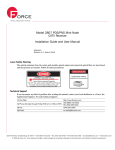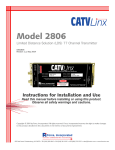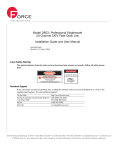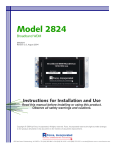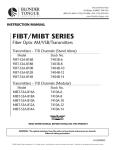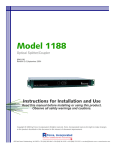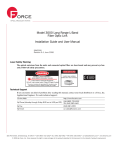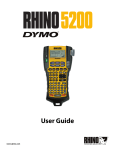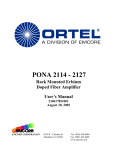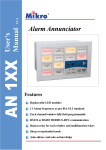Download Model 2805
Transcript
Model 2805 Private Network Solution (PNS) 110 Channel Transmitter IOM2805 Revision 1.1, December 2003 Instructions for Installation and Use Read this manual before installing or using this product. Observe all safety warnings and cautions. Copyright © 2003 by Force, Incorporated. All rights reserved. Force, Incorporated reserves the right to make changes to the product described in this document in the interest of document improvement. 825 Park Street Christiansburg, VA 24073 • TEL (540) 382-0462 • FAX (540) 381-0392 • USA (800) 732-5252 • [email protected] • www.forceinc.com Model 2805 CATVLinx® PNS Transmitter Preface WARNING The optical emissions from the chassis and connected optical fiber are laser-based and may present eye hazards. Follow all safety precautions About this Manual This manual explains how to configure and install the Model 2805 Private Network Solution (PNS) transmitter. It is intended for engineers and technicians who will install the 2805 units and their companion receiver(s). While this guide provides basic information on how to configure and install the units, it assumes that you as the user are familiar with: • the installation and manipulation of electronic and fiber optic equipment • the installation and manipulation of CATV video/audio equipment This manual is divided into the following sections: • Section 1, page 1: Describes the Private Network Solution (PNS) transmitter, lists technical specifications, performance graphs, system applications, and ordering information. • Section 2, page 9: Describes the installation of the PNS transmitter and its companion receiver(s). • Section 3, page 15: Describes the operation of the PNS CATV link, troubleshooting, and user maintenance. A quick-reference index completes the user manual. Revision 1.1 ii Model 2805 CATVLinx® PNS Transmitter Preface Related Documentation • • • • • • • IOM2807: User manual for Model 2807 Mini-node Receiver IOM2808: User manual for Model 2808 PDS/PNS CATV Receiver AN123: North American Television Frequencies AN128: Care and Feeding of Analog CATV Fiber Optic Links AN141: System Solutions for CATV HFC Networks Fiber Optic Reference Guide, 3rd Edition. by David R. Goff (Focal Press 2002): General theory and operation of fiber optic units. Web Site: Our web site, http://www.forceinc.com may be used to download the latest versions of this manual. Technical Support If you encounter any kind of problem after reading this manual, contact your local distributor or a Force, Inc. Applications Engineer. To reach technical support: On the Web: http://www.forceinc.com By Phone (Monday through Friday 8:00 am to 5:00 pm EST): USA (800) 732-5252 TEL (540) 382-0462 By Fax: (540) 381-0392 By Email: [email protected] Warranty Force, Incorporated standard products are warranted to be free from defects in materials and workmanship, meeting or exceeding factory specified performance standards for a period of three (3) years from date of purchase. Force Obligations Force will, at its discretion and expense, repair any defect in materials or workmanship or replace the product with a new product. Force will, upon receipt of the return, evaluate the product and communicate to the customer the nature of the problem, and determine if the claim falls under warranty coverage. If during the warranty period, Force is unable to repair the product to the original warranted state within a reasonable time, or if subcomponents of the unit have been obsoleted or discontinued, then Force has the option to provide an equivalent unit. Revision 1.1 iii Model 2805 CATVLinx® PNS Transmitter Preface Exclusions This warranty does not extend to any product that has been damaged due to acts of God, accident, misuse, abuse, neglect, improper system design or application, improper installation, improper operation or maintenance, or connection to an improper voltage supply. The Force warranty does not cover fuses, batteries, and lamps. Modifications or alterations of Force products (including but not limited to installation of non-Force equipment or computer programs), except as authorized by Force, will void this warranty. Removal or breaking of the seals on the product will also void the warranty. In addition, cost of repair by unauthorized persons within the warranty period of the product will not be covered by Force, Incorporated. Such repairs will void the warranty. Force, Incorporated makes no other representation or warranty of any other kind, express or implied, with respect to the goods, whether as to merchantability, fitness for a particular purpose, or any other matter. Force, Incorporated’s liability shall not include liability for any special, indirect or consequential damages, or for any damages arising from or attributable to loss of use, loss of data, loss of goodwill, or loss of anticipated or actual revenue or profit, or failure to realize expected savings, even if Force, Incorporated has been advised of the possibility of such damages. This warranty constitutes Force, Incorporated’s entire liability and the customer’s sole remedy for defects in material and workmanship. iv Revision 1.1 Model 2805 CATVLinx® PNS Transmitter Contents Preface................................................................................................................. ii Section 1 Product Technical Bulletin..................................................................... 1 1.1 Product Overview................................................................................................. 1 1.2 FCC Notice ........................................................................................................... 1 1.3 Optical, Video, Electrical Characteristics ................................................................ 2 1.4 Environmental and Physical Characteristics ........................................................... 2 1.5 Specification Notes ............................................................................................... 2 Figure 1.1 In-Band Frequency Response .......................................................... 2 Figure 1.2 Expanded Frequency Response ....................................................... 3 Figure 1.3 CNR vs. Rx Optical Input and Channel Loading .............................. 4 Figure 1.4 Transmitter Level per Channel vs. Number of Channels .................. 4 Figure 1.5 Transmitter Level per Channel vs. Log10 ......................................... 5 Figure 1.6 Response of Model 2805 RF Power Meter ...................................... 5 Figure 1.7 Top Label Used to Determine RF Input for Transmitter ................... 6 1.6 Applications.......................................................................................................... 6 Figure 1.8 Point-to-Multipoint Private Network Solution ................................. 6 1.7 Part Numbers ....................................................................................................... 7 Section 2 Installation Instructions......................................................................... 9 2.1 General Installation Requirements......................................................................... 9 2.2 Items Provided...................................................................................................... 9 2.3 Items Required ..................................................................................................... 9 2.4 Inspection........................................................................................................... 10 2.5 Equipment Rack Configuration ........................................................................... 10 2.6 Measuring RF Input Levels at the Transmitter ..................................................... 10 2.7 Connections ....................................................................................................... 11 Revision 1.1 v Contents Model 2805 CATVLinx® PNS Transmitter 2.8 Front Panel Physical Description.......................................................................... 12 Figure 2.1 Transmitter Front Panel.................................................................12 2.9 Rear Panel Physical Description........................................................................... 13 Figure 2.2 Transmitter Rear Panel .................................................................. 13 2.10 Safety Precautions ............................................................................................ 13 2.10.1 Laser Safety Procedures ....................................................................13 2.11 Shipping and Handling Precautions ................................................................... 14 2.12 Storing the Unit ................................................................................................ 14 Section 3 Operating Instructions ........................................................................ 15 3.1 Connections and Power-up................................................................................. 15 3.2 Performance Verification..................................................................................... 16 3.3 User Maintenance............................................................................................... 17 3.4 Repair Service ..................................................................................................... 17 3.5 Cleaning ............................................................................................................. 17 3.5.1 Optical Connector Cleaning Equipment ..............................................17 3.5.2 Directions for Optical Connector Cleaning ..........................................17 3.5.3 Connector Handling...........................................................................18 3.6 Troubleshooting.................................................................................................. 18 3.7 Problems and Comments .................................................................................... 18 Index ................................................................................................................. 21 vi Revision 1.1 Model 2805 CATVLinx® PNS Transmitter Section 1 Product Technical Bulletin 1.1 Product Overview The Force, Incorporated CATVLinx® Model 2805 110 Channel CATV Private Network Solution (PNS) Transmitter is part of a robust system for transferring up to 110 channels of VSB/AM modulated signals over a single-mode optical fiber. The Model 2805 provides 40-870 MHz of usable bandwidth for video signals stacked at 6 MHz intervals. A low loss single-mode fiber allows full channel loading to beyond 20 km while maintaining a good carrier-to-noise ratio. The Model 2805 may be used with the Model 2807 Mini-node receiver for use in return path and multiple splitter applications or with the Model 2808 PDS/PNS receiver for basic 110 channel CATV transmission. In all cases, the link provides excellent performance for many demanding applications such as broadband LANs, distance learning, and multiple data services. 1.2 FCC Notice The Model 2805 has been tested and found to comply with the limits for a Class A digital device, pursuant to Part 15 of the FCC Rules. These limits are designed to provide reasonable protection against harmful interference when the equipment is operated in a commercial environment. This equipment generates, uses, and can radiate radio frequency energy and, if not installed and used in accordance with the instructions in this manual, may cause harmful interference to radio communications. Operation of this equipment in a residential area is likely to cause harmful interference, in which case the user must correct the interference at the user’s own expense. Compliance with applicable regulations depends on the use of shielded I/O cables. The user is responsible for procuring the appropriate cables. Revision 1.1 1 Model 2805 CATVLinx® PNS Transmitter Product Technical Bulletin 1.3 Optical, Video, Electrical Characteristics: @ 25 °C, SM Fiber (Note 13) Min. Channel Loading Bandwidth Operating Wavelength Optical Output Power Required Fiber Bandwidth Input/Output Impedance Side Mode Suppression Ratio (SMSR) Backreflection Tolerance Carrier-to-Noise Ratio (CNR) Composite Second Order (CSO) Composite Triple Beat (CTB) Input Signal Range (per ch.) Max. Units 110 40 870 1290 1310 1330 See Section 1.7 2,000 75 30 50 See Figure 1.3 -60 -65 See Figures 1.4 and 1.5 Ch. MHz nm Power Supply Voltage Power Supply Frequency Power Dissipation Fuse (Slow-Blow) 1.4 Typ. 1 2 3 4 5 dB dB 6, 7 120 240 VAC 8 50 60 Hz Watts A 8 20 1.25 9 Environmental and Physical Characteristics Min. Operating Temperature Range Storage Temperature Range Humidity Weight Typ. 0 -20 0 Max. Units +45 +70 90 °C °C % lbs. kg in. mm 5.5 2.5 19 W x 1.72 H x 14.1 D 483 x 43.7 x 358 Physical Dimensions 1.5 MHz Ohms dB dB Notes See Section 1.5 Notes See Section 1.5 10 11 12 12 Specification Notes 1) Figure 1.1 shows the typical frequency response of a 2805 link over the specified frequency range. The gain flatness is typically ±1.0 dB over this range. The flatness is typically less than ±0.1 dB over a standard 6 MHz channel bandwidth. See Application Note AN123 for additional information on North American Television Frequencies. 10 Response (dB) 5 0 -5 -10 -15 -20 0 100 200 300 400 500 600 700 800 900 1000 Frequency (Hundreds MHz) 2805T with 2807R 2805T with 2808R Figure 1.1 In-Band Frequency Response 2 Revision 1.1 Model 2805 CATVLinx® PNS Transmitter Product Technical Bulletin Figure 1.2 shows an expanded view of the frequency response of a typical 2805T/2808R link. 10 8 6 Response (dB) 4 2 0 -2 -4 -6 -8 -10 40 91 142 2805T with 2807R 193 244 295 346 Frequency (MHz) 397 448 499 550 2805T with 2808R or 2809R Figure 1.2 Expanded Frequency Response 2) All optical power levels are average values. Output is Class IIIb laser. See part numbers in Section 1.7, page 7 for available optical power options. 3) Be sure to compute your fiber bandwidth (end-to-end) as well as attenuation. 4) The Model 2805 incorporates an optical isolator in the laser package that reduces the effect of optical backreflections on the laser performance. However, all analog lasers are affected by optical backreflections. The 2805 can only achieve published performance levels if the fiber between the transmitter and receiver has a maximum optical backreflection of -50 dB. Optical backreflection levels above -50 dB will increase the noise floor of the laser (i.e. decrease the carrier-to-noise ratio), worsen both CSO and CTB performance, increase passband ripple, and dramatically increase cross modulation. The result will be a noisy, grainy picture with diagonal bars. Force, Inc. recommends that all fiber connections be SC/APC type, FC/APC type or fusion spliced. There is some folklore which suggests that the only critical backreflection is the one closest to the transmitter. Our experience does not support that view. We find that all backreflections matter, regardless of their distance from the transmitter. 5) Figure 1.3 presents a tremendous amount of performance data for the 2805 link. The horizontal axis is the amount of optical light that reaches the receiver. (It is not the loss between the transmitter and receiver.) The vertical axis shows the carrier-to-noise ratio at a given optical input level. Revision 1.1 3 Product Technical Bulletin Model 2805 CATVLinx® PNS Transmitter Figure 1.3 CNR vs. Rx Optical Input and Channel Loading (2805T with 2808R) The vertical scale is the carrier-to-noise (CNR) ratio. Five curves are plotted against these axes. The top curve is the typical result when only 5 channels are transmitted through the link. It can be seen that very high CNR results and in fact the output is quite usable with receiver optical inputs as low as -12 dBm, corresponding to 22 dB of optical loss! As the channel loading gets higher, the maximum achievable CNR drops. Note that the link CNR is usually specified for a received optical power of -2 dBm or more. Thus, a 2805TF-SCAP/12 optical transmitter, with an optical output of +12 dBm, will provide optimal performance with up to 14 dB of optical loss at full channel loading. If lower channel loading is used, then the link can operate at higher optical losses and still provide exceptional CNR. 6) The recommended RF input level is shown in Figures 1.4 and 1.5. WARNING Exceeding the RF input level may instantaneously destroy the transmitter. Both figures show the same information, the transmitter level per channel versus the number of channels being transmitted; however, in Figure 1.5 the horizontal scale is a logarithmic scale. This shows that the underlying relationship is linear if plotted against the logarithm of the number of channels. Figure 1.4 Transmitter Level per Channel vs. Number of Channels 4 Revision 1.1 Model 2805 CATVLinx® PNS Transmitter Product Technical Bulletin Figure 1.5 Transmitter Level per Channel vs. Log10 (Number of Channels) Figure 1.6 shows the response of the Model 2805 transmitter’s integral RF power meter. This meter is accessed via pin J4-5 of the 9-pin D-sub connector on the rear of the transmitter. Figure 1.6 Response of Model 2805 RF Power Meter 7) Each transmitter has a label such as the one shown in Figure 1.7 that gives the RF input levels for the transmitter. The individual carrier levels should closely match each other to ensure consistent performance on all channels. In all cases, set the composite RF input level so that the RF INPUT LEVEL LED is green. The RF indicator LED only operates properly for rated channel loading and a flat input spectrum. To use the chart, look up the channel loading you will be presenting to the transmitter input and read off the drive level per video carrier. For instance, with 40-channel loading, each video carrier should be about +25.0 dBmV. Revision 1.1 5 Product Technical Bulletin Model 2805 CATVLinx® PNS Transmitter Figure 1.7 Top Label Used to Determine RF Input for Transmitter 8) The Tx rear panel power module can accept voltage levels from 120 to 240 VAC at 50 to 60 Hz. 9) Fuse Rating is 1.25 A, Slow-Blow. CAUTION Risk of fire. Only use fuses with same type and rating as marked. 10) Most parameters are relatively unaffected by varying temperature. A moving air environment is recommended at ambient temperatures above +35°C. 11) Humidity is RH non-condensing. 12) Dimensions include L-brackets for mounting the chassis to an EIA 19" equipment rack. 13) The CATVLinx® Model 2805 is optimized for single-mode operation only. Use on multimode fiber is not recommended, even for short distances, because of the large amount of modal noise that could result. 1.6 Applications Figure 1.8 illustrates a point-to-multipoint CATV network. The Force, Inc. Model 1188 Optical Splitter/Coupler splits the output from Model 2805 transmitter, allowing a single transmitter to drive multiple Model 2808 receivers. Figure 1.8 Point-to-Multipoint Private Network Solution 6 Revision 1.1 Model 2805 CATVLinx® PNS Transmitter 1.7 Product Technical Bulletin Part Numbers Part Number Tx Optical Output CATV Channel Loading Optical Connector Type 2805TD-SCSP/06 +6 dBm 110 Channels SC/APC 2805TD-SCSP/08 +8 dBm 110 Channels SC/APC 2805TE-SCSP/10 +10 dBm 110 Channels SC/APC 2805TF-SCSP/12 +12 dBm 110 Channels SC/APC 2805TG-SCSP/13 +13 dBm 110 Channels SC/APC 2805TD-SCAP/06 +6 dBm 110 Channels FC/APC* 2805TD-SCAP/08 +8 dBm 110 Channels FC/APC* 2805TE-SCAP/10 +10 dBm 110 Channels FC/APC* 2805TF-SCAP/12 +12 dBm 110 Channels FC/APC* 2805TG-SCAP/13 +13 dBm 110 Channels FC/APC* *Note: The FC/APC interface uses the “wide-key” standard. This means that the units are optimized for use with FC/APC connectors that have a 2.14 mm wide alignment key. “Narrow-key” FC/APC connectors (2.02 mm) may be used but will produce inferior results. Standard FC/PC connectors have a 2.36 mm wide key and cannot be plugged into either unit. Revision 1.1 7 Product Technical Bulletin Model 2805 CATVLinx® PNS Transmitter Notes: 8 Revision 1.1 Model 2805 CATVLinx® PNS Transmitter Section 2 Installation Instructions 2.1 General Installation Requirements The installation of these units is very simple. There are no special unpacking instructions, except that care should be taken to handle units gently. Fiber optic links are sensitive electronics devices that should be handled with care. Like most electronics, they are susceptible to ESD. Proper ESD techniques, such as wearing a wrist grounding strap, should be observed at all times when handling a unit. The units should not be dropped. No assembly is required. Do not install the equipment near sources of excessive heat, such as furnace outlets or above heat producing units, such as large power supplies and tube-type equipment. Observe temperature and relative humidity requirements specified in Section 1.4, page 2. WARNING Potentially hazardous uninsulated voltages exist beneath the top panel. 2.2 Items Provided The following is a list of items provided with each Model 2805 PNS Fiber Optic Video Transmitter: Qty. Mfr. P/N AR Force, Inc. 2805TX-SCXX/XX 1 per connector Any Any Active Device Receptacle Cap for optical and RF connectors 2804.342-2 L-Bracket Mounting Ears. Allows the Tx chassis to be installed in a 19" wide rack. 2 per unit Force, Inc. 1 per unit 2.3 Any Any Description CATVLinx® 110 Ch. PNS Transmitter Three-wire ground AC power cable. Items Required Qty. Mfr. P/N Description AR Force, Inc. 2807RX-SFXX CATVLinx Mini-node CATV Receiver AR Force, Inc. 2808RX-SFXX CATVLinx® PDS/PNS CATV Receiver 4 per unit Any Any 6-32 Panhead Mounting Screws with Lock Washers and Nuts (used to mount the receivers) 1 Any Any Straight Screwdriver Revision 1.1 ® 9 Model 2805 CATVLinx® PNS Transmitter Installation Instructions 2.4 Qty. Mfr. P/N Description AR Any Any EIA Standard 19" Grounded Equipment Rack with Hardware to Install the Transmitter into the Rack. 9/125 µm Single-mode Fiber AR Any Any 1 per 2807 Force, Inc. PS200 1 per 2808 Any Any Wall-mount Power Supply (Model 2807R only) Three-wire ground AC power cable. Inspection Remove the unit from its shipping container. Any in-shipment damage that may have occurred should be visually apparent. Look for bent or damaged connectors or mounting brackets. Claims for damage incurred in shipment should be made directly to the transportation company in accordance with their instructions. Save the shipping cartons until installation and performance verification are completed. 2.5 Equipment Rack Configuration Carefully unpack the chassis, and install it in your earth grounded equipment rack. Make sure to load the heaviest equipment near the bottom of the rack and the lightest equipment at the top of the rack. The surface of the equipment rack that mates to the chassis mounting ears should be conductive. The unit should be located in an area that provides adequate lighting and is relatively free from dust. The units are each housed in a single EIA standard 1RU (1.75 inch) rack-mount chassis. To ensure the unit does not overheat, leave 1RU of space above and below each installed chassis. When connecting power to the chassis, take care as to not overload the branch circuit supplying power to whatever is already connected. Also, make sure there are no obstructions in the natural convection air exhaust or inlet paths. 2.6 Measuring RF Input Levels at the Transmitter Excessive RF input to a fiber optic CATV transmitter WILL kill the laser even if the unit is not powered. Lasers can be destroyed by being overdriven for as little as one nanosecond (10-9 seconds). Because they can be destroyed so quickly, it is essentially impossible to design a circuit or “fuse” that will blow before the laser is destroyed. Therefore it is imperative that the RF level be within acceptable limits BEFORE the cable is attached to the transmitter. See the “Drive Level per Video Carrier” top label (see Figure 1.7) on the transmitter for the optimum drive levels, and follow the steps below. 1) Using a spectrum analyzer, determine that the RF level input to the transmitter is within safety bounds. The unit is shipped with a 20 dB attenuator on the input to protect against accidental overload on initial hookup. (An additional 20 dB attenuator may be added for absolute security.) This attenuator should be removed once RF levels are verified to be nominal. 2) The “Drive Level per Video Carrier” chart on top of the transmitter gives the nominal RF input level for channel loading from 1 to 110 channels. Note that the chart is in dBmV units per channel, not dBm. DO NOT exceed the values shown on the chart. 3) The “RF Input Level” LED on the front panel gives a positive indication of the RF level. If the LED is yellow, the RF level is too low. Increase in 2 dB steps until the LED turns green. If the LED is red, the RF input level is too high. Disconnect the RF input immediately. Decrease RF levels by 6 dB steps and 10 Revision 1.1 Model 2805 CATVLinx® PNS Transmitter Installation Instructions reconnect the RF input until the LED turns yellow or green. If it turns yellow, increase RF levels by 2 dB steps until the LED turns green. Ideally, the RF level should be checked with an instrument such as a spectrum analyzer to verify that the levels are appropriate. If instrumentation is not available to actually measure the RF levels, Force recommends adding 40 dB of attenuation at the transmitter input; 40 dB of attenuation will adequately protect the unit from the highest RF levels that might be seen in a typical CATV installation. Do not attach the RF cable at this time, just verify the RF levels and/or add the appropriate attenuators at the transmitter input. 2.7 Connections Connector Name RF Input Optical Output Connector Type 9-Pin D-Sub Status Output Connector Function F Type RF input to the transmitter SC/APC (Std.), FC/APC* Optical output from the transmitter (Option) It is imperative that backreflections be controlled to very low levels. Pin Function 1 2 3 4 5 6 7 8 9 +5 V Power RF Level Status Laser Status TEC Cooler Status RF Power Meter Ground Ground Ground Ground Accepts a standard IEC Power Input power cord. * Note: The FC/APC interface uses the “wide-key” standard. This means that the units are optimized for use with FC/APC connectors that have a 2.14 mm wide alignment key. “Narrow-key” FC/APC connectors (2.02 mm), often referred to as JDS compatible, may be used but will produce inferior results. Standard FC/PC connectors have a 2.36 mm wide key and cannot be plugged into either unit. Power/Rear Panel Revision 1.1 11 Model 2805 CATVLinx® PNS Transmitter Installation Instructions 2.8 Front Panel Physical Description A A. B. C. D. E. B C Mounting Brackets: Adapts the 1RU chassis for use in an EIA standard 19” wide rack. Handles: For easy removal and installation of 1RU chassis with mounting brackets into a 19" wide rack. Power Switch: Turns the transmitter on and off. Power Indicator LED (Green LED): The LED is on when the unit is receiving AC power and off when there is no power to the unit. RF Input Level LED (Tri-colored Green/Yellow/ Red LED): This LED indicates the RF signal input level into the transmitter. The RF input indicator is green when the RF signal input is within ±1.5 dB of the optimum input level. When the signal input falls below the optimum ±3 dB range, the LED becomes yellow. When the signal input rises above the optimum range, the LED turns red. WARNING DO NOT EXCEED THE RECOMMENDED RF INPUT LEVEL. EXCESSIVE LEVELS OF RF INPUT WILL DESTROY THE TRANSMITTER. F. D E G. F G B A Laser Status LED (Bi-colored Green/Red LED): When green, this LED indicates that the laser is initialized and operating normally. Lights red to indicate operation above normal operating temperature range. See Section 1.3, page 2 for normal operating temperatures or contact factory. NOTE Normally, this LED will be red or change from red to green in the first ten seconds after power has been applied to the transmitter. During this ten second initialization period, the laser is held in shutdown mode while the rest of the circuitry initializes. It is then switched to normal operation, and the LED turns green. If the LED turns red at any time other than in the first ten seconds of operation, this may indicate a laser failure. See the warning label on top of the unit (Figure 1.7, page 6) for instructions on acheiving the recommended RF input level. Cooler Status LED (Bi-colored Green/Red LED): When green, this LED indicates that the laser cooler (TEC) is functioning normally, and the laser temperature is stable. NOTE Normally, this LED will be red or change from red to green in the first ten seconds after power has been applied to the transmitter. If the LED turns red at any time other than in the first ten seconds of operation, the unit should be turned off IMMEDIATELY to avoid laser damage. Figure 2.1 Transmitter Front Panel 12 Revision 1.1 Model 2805 CATVLinx® PNS Transmitter 2.9 Installation Instructions Rear Panel Physical Description B A C D E 1.72" (43.69) 17.00" (431.80) VSB/AM VIDEO TRANSMITTER PART NO. 2805TD-SCSP/06 WAVELENGTH 1310 nm SERIAL NO. 310023 F 825 Park Street Christiansburg, VA 24073 http://www.forceinc.com Made in USA A. B. C. Heat Sink: Dissipates excess heat from the transmitter. RF Input (F Connector): RF signal input into the transmitter. Warning label below advises not to exceed the RF input level, or the transmitter may be destroyed. Optical Output (SC/APC or FC/APC): Optical output from the transmitter. A dust cover should be placed over the connector when not in use. WARNING OPTICAL LASER RADIATION IS PRESENT AT THE TRANSMITTER’S CONNECTOR WHEN THE UNIT IS TURNED ON. AVOID DIRECT EYE EXPOSURE TO THE INVISIBLE BEAM. D. E. Status Output (DB9 Connector): Transmitter remote status monitoring connection. See Section Section 2.7, page 11 for pin connections. AC Power Input and Fuse Holder: Connects to primary AC power via a detachable three-wire grounded power cord. CAUTION Connect only to a three-wire grounded outlet. Do not defeat the purpose of this ground. The fuse type is 1.5A, Slow Blow. F. Unit Serial Number: The unit serial number is a date code that identifies the start date of the product warranty. See page iii for Force’s Standard Warranty. Figure 2.2 Transmitter Rear Panel 2.10 Safety Precautions The optical emission from the units are laser-based Class IIIb, and may present eye hazards if improperly used. NEVER USE ANY KIND OF OPTICAL INSTRUMENT TO VIEW THE OPTICAL OUTPUT OF THE UNIT. As always, be careful when working with optical fibers. Fibers can cause painful injury if they penetrate the skin. 2.10.1 Laser Safety Procedures 1) ALWAYS read the product data sheet and the laser safety label before powering the product. Note the operating wavelength, optical output power, and safety classification. 2) If safety goggles or other eye protection are used, be certain that the protection is effective at the wavelength(s) emitted by the device under test BEFORE applying power. 3) ALWAYS connect a fiber to the output of the device BEFORE power is applied. Power should never be applied without an attached fiber output. If the device has a connector output, a connector should be attached that is connected to a fiber. This ensures that all light is confined within the fiber waveguide, virtually eliminating all potential hazard. Revision 1.1 13 Model 2805 CATVLinx® PNS Transmitter Installation Instructions 4) NEVER look in the end of a fiber to see if light is coming out. NEVER! Most fiber optic laser wavelengths (1310 nm and 1550 nm) are totally invisible to the unaided eye and will cause permanent damage. Shorter wavelength lasers (e.g. 780 nm) are visible and are very damaging. Always use instruments, such as an optical power meter, to verify light output. 5) NEVER NEVER NEVER look into the end of a fiber on a powered device with ANY sort of magnifying device. This includes microscopes, eye loupes, and magnifying glasses. This WILL cause a permanent, irreversible burn on your retina. Always double check that power is disconnected before using such devices. If possible, completely disconnect the unit from any power source. 6) If you have questions about laser safety procedures, please call Force, Incorporated for assistance before powering your product. A Sales Engineer or Applications Engineer may be reached at (540) 382-0462. 7) Laser safety classes for the Model 2805 are as follows: Class IIIb 2.11 Wavelength Range Optical Power Accession Limits 180 nm to 400 nm Varies with λ and exposure time. 400 nm to 106 nm 0.5 Watt Shipping and Handling Precautions The units are, in general, very rugged and can withstand the stresses of most shipping and handling circumstances. However, the following precautions should be taken: 1) When the units are shipped they should be wrapped in a protective material, such as bubble wrap, to protect against excessive jarring and to prevent damage to the external finish of the units. Always use packing material to separate multiple units that are packaged together. 2) Care should be taken not to drop or strike the units in any way, especially around the optical connectors. 3) The units should never be submersed in any liquid. SEVERE SHOCK HAZARD! 2.12 Storing the Unit If a unit is to be out of use for an extended period of time, the following steps should be taken to ensure the preservation of the unit: 1) The storage temperature range is -20°C to +70°C. 2) A low humidity environment is preferable for long term storage. 3) All connectors should be covered with active device receptacle caps. 14 Revision 1.1 Model 2805 CATVLinx® PNS Transmitter Section 3 Operating Instructions 3.1 Connections and Power-up 1) Install the links as described in Section 2, page 9 of this document. 2) Measure the RF level BEFORE making any connections to the transmitter. This measurement is described in Section 2.6, page 10. 3) Clean the optical connectors. See Section 3.5, page 17 for cleaning instructions. Be sure all optical connectors are APC type. 4) Connect the optical fiber to the transmitter and the receiver (see receiver IOM). Be sure that the fiber has continuity and less than the maximum allowable optical loss. Also be certain that the fiber is the proper size. This product can only be used with single-mode fiber. The input power to the Rx must be less than +4.5 dBm. The units will not work back-to-back. The optical input level to the Rx can be ascertained by checking the color of the “OPTICAL LEVEL” indicator LED on the Rx. Red LED = Too much optical power Green LED = Correct optical power level Yellow LED = Not enough optical power 5) Connect the RF source (VCR, camcorder, cable television, etc.) to the RF input on the transmitter. 6) Connect the AC power cord to the back of the transmitter. Because the laser is thermometrically cooled and is a high performance item, the startup and stabilization sequence is 15-30 seconds long. The front panel of the 2805T has four LED indicators. One is green only and the other three are tri-color LEDs. The normal startup sequence is as follows: Action Power LED Unit Off Dark RF Input Level LED Cooler Status LED Dark Apply Power Green Yellow, Note 1 Red, Note 2 Red, Note 2 5-20 Sec. Green Yellow, Note 1 Green, Note 2 Red, Note 2 8-14 Sec. Green Yellow, Note 1 Green, Note 2 Green, Note 1 Dark Laser LED Dark Note 1: At any time, the RF input will be yellow if the RF input level is too low, green if it is within the nominal RF input band, and red if the RF input is too high. Note 2: At any time, if the laser temperature is too high, the COOLER STATUS LED will change from green to red. This will cause the LASER LED to go red as well. Revision 1.1 15 Operating Instructions Model 2805 CATVLinx® PNS Transmitter When power is first applied, the POWER and RF INPUT LEVEL LEDs should be green. The COOLER STATUS and LASER LED will light red or change from red to green to indicate normal operation. If the “RF Input Level” LED is red, this means the RF level is too high. DISCONNECT THE RF INPUT IMMEDIATELY. Add the attenuator, then reconnect the RF input and observe the LED color. Repeat as necessary until the LED is green. If the “RF Input Level” LED is yellow, this means the RF level is too low. Increase the input level until the LED is green. WARNING OPTICAL LASER RADIATION IS PRESENT AT THE OPTICAL CONNECTOR WHEN THE UNIT IS ACTIVATED. AVOID DIRECT EYE EXPOSURE TO THE BEAM. 7) Connect power supply to the receiver. For Model 2807: The power supply must be from +12 to +16 Volts DC. It is critical that the supply voltage never drops below +12 Volts. If the voltage drops below +12 Volts, the link may not operate. Force, Inc. recommends the Model PS200 wall-mount power supply for use with the Model 2807 receiver. For Model 2808: The Model 2808 receiver uses an integral AC power supply which uses a standard 3-wire ground AC power cord. For all receivers: When power is applied and the link is operational, the “Optical Level” LED should light green to indicate the optimum optical input level. If the optical input level is too low, the LED will be yellow. The LED also doubles as a power indicator. WARNING OPTICAL LASER RADIATION IS PRESENT AT THE OPTICAL FIBER THAT ATTACHES TO THE RECEIVER’S OPTICAL CONNECTOR WHEN THE UNITS ARE ACTIVATED. AVOID DIRECT EYE EXPOSURE TO THE BEAM. 8) The units are now fully operational. Verify the proper operation of the link by following the steps in Section 3.2, page 16. No other user adjustment or attention is required. See Section 3.3, page 17 for instructions on maintaining and cleaning the link. See Section 3.6, page 18 for information on troubleshooting. 3.2 Performance Verification Once the units have been installed, verify that the picture quality is good. If the picture quality is not good, there are several likely causes: 1) The optical fiber may have large backreflections. Use an OTDR to examine the fiber run. 2) There may be non-APC optical connectors somewhere in the system. These cause unacceptable levels of backreflection. 3) The RF input spectrum may not be flat. It is possible to have a green RF Level LED even if the input spectrum has a large amount of tilt. All Force CATV products are designed to operate with a flat input spectrum. 4) There may extraneous (i.e., non-video) signals in the input RF. Be sure to filter out all non-desirable signals. 5) The optical input power at the receiver may be too low. In this case, the optical status LED will be yellow. See Figure 1.3 for the expected CNR versus the channel loading and received optical power. 16 Revision 1.1 Model 2805 CATVLinx® PNS Transmitter 3.3 Operating Instructions User Maintenance No user maintenance is required. The Model 2805 CATVLinx® 110 Channel Private Network Solution Transmitter contains no user-serviceable parts and requires no routine service. Contact the factory if the unit requires warranty repair work. See Section 3.6, page 18 for troubleshooting. 3.4 Repair Service For equipment repair or technical assistance, contact Customer Service (800) 7325252 (USA) or (540) 382-0462. A Returned Material Authorization (RMA) number must be issued by Customer Service before the return of a failed unit. Units should be returned in their original shipping carton, if available. Always include a complete description of the failure or observed anomalies. All units are marked with model number and serial number. This identification sticker is placed on the rear panel (transmitter) or on the product label (receiver). The serial number is a date code used as a reference for warranty service. 3.5 Cleaning If the units need to be cleaned, avoid the use of all solvents and use low-pressure clean air to remove loose dirt. Use low-pressure clean air to clear the connectors of any debris. Dirty or scratched connector end faces will greatly reduce the unit’s performance. Foam-tipped swabs such as the 2.5mm Mini Foam Swab offered by Fiber Instrument Sales (P/N F1-0005) may be saturated with denatured alcohol (see note below) and inserted into the optical port for cleaning. DO NOT INSERT A DRY SWAB INTO THE OPTICAL PORT AS THIS MAY DAMAGE THE FIBER END FACE. Many fiber optic installations experience degraded performance due to dirty optical connector end faces. The following procedure should be used to properly clean the optical connector end faces. 3.5.1 Optical Connector Cleaning Equipment • Kimwipes® or any lens-grade, lint-free tissue. The type sold for eyeglasses work quite well. • Denatured Alcohol. NOTE Use only industrial grade 99% pure isopropyl alcohol. Commercially available isopropyl alcohol is for medicinal use and is diluted with water and a light mineral oil. Industrial grade isopropyl alcohol should be used exclusively. • 30X Microscope. • Canned Dry Air. 3.5.2 Directions for Optical Connector Cleaning 1) Fold the tissue twice so it is four layers thick. 2) Saturate the tissue with alcohol. 3) First clean the sides of the connector ferrule. Place the connector ferrule in the tissue, and apply pressure to the sides of the ferrule. Rotate the ferrule several times to remove all contamination from the ferrule sides. 4) Now move to a clean part of the tissue. Be sure it is still saturated with alcohol, and it is still four layers thick. Put the tissue against the end of the connector ferrule. Put your fingernail against the tissue so that it is directly over the ferrule. Now scrape the end of the connector until it squeaks. It will sound like a crystal glass that has been rubbed when it is wet. Revision 1.1 17 Model 2805 CATVLinx® PNS Transmitter Operating Instructions 5) Use the microscope to verify the quality of the cleaning. If it isn’t completely clean repeat the steps with a clean tissue. 6) Mate the connector immediately! Don’t let the connector lie around and collect dust before mating. 7) Air can be used to remove lint or loose dust from the port of a transmitter or receiver to be mated with the connector. Never insert any liquid into the ports. 3.5.3 Connector Handling 1) NEVER TOUCH THE FIBER END FACE OF THE CONNECTOR. 2) Connectors not in use should be covered over the ferrule by a plastic dust cap. It is important to note that inside of the ferrule dust caps contains a sticky gelatinous residue that is the by-product of the making of the dust cap. This residue will remain on the ferrule end after the cap is removed. Therefore it is critical that the ferrule end be cleaned thoroughly BEFORE it is mated to the intended unit. 3.6 Troubleshooting Common problems include lack of continuity in the optical fiber, lack of power (or reversed power), or improper input levels. The units are designed to work with a 75 Ohm system. A number of indicator LEDs may assist in troubleshooting. These allow the user to quickly assess the nature of any major unit malfunctions. If problems persist consult the Force, Inc. reference materials listed below, or contact the factory. 3.7 Problems and Comments Problem Check Comments Verify that the AC power cord is firmly attached to the back of the transmitter, and verify the integrity of the power If no AC power is reaching the cord. Be sure that the primary unit, the “Power” LED on the power source has not been transmitter will be off. Check inadvertently turned off and Tx power connection. that no fuses have blown in the unit or at the power source. Plug in the power cord. No optical power out of Tx. No optical power at the Rx. 18 If the unit is receiving AC power (“Power” LED is green), check the “Laser” LED. If this is red, check the “Cooler Status” LED. If the “Cooler Status” LED is green, the problem may be in the laser. If the “Cooler Status” LED has also turned red, the TEC cooler has failed and the laser is in danger of overheating. Remove power from the unit immediately. If the Tx “Laser” LED is red but the “Cooler Status” LED is green, try turning the transmitter off and back on. The “Laser” and “Cooler Status” LEDs should light red within the first ten seconds of unit initialization and then turn green. If either of these LEDs remains red, contact Force, Inc. for additional instructions. Check power at the Tx. If there is power at the Tx, verify proper fiber is connected to the Rx, and ensure the integrity of the fiber. Revision 1.1 Model 2805 CATVLinx® PNS Transmitter Problem Low optical power at the Rx. Operating Instructions Check Comments Check optical output power at the Tx. Check optical connector type (APC). Check fiber integrity. This product requires all APC optical connectors. Verify that the Tx power is on. Contact the factory for additional instructions. No signal out of Rx.; “Optical Verify the input signal at the Level” indicator LED is either Tx. yellow, red or unlit. Signal out of Rx is distorted. A larger signal will cause distortion, and may destroy the Verify input signal at Tx. The transmitter. If the RF level is Tx “RF Input Level” LED should too high, the LED will be red. be green. Adjust the input level until the LED turns green. Verify fiber size. Revision 1.1 The Tx “RF Input Level” LED should be green. If the LED is either red or yellow, the signal input has fallen outside of the ±1.5 dB range. If the Tx “RF Input Level” LED is green, the receiver may be in need of repairs. Contact the factory for additional instructions. Use single-mode fiber only. 19 Operating Instructions Model 2805 CATVLinx® PNS Transmitter Notes: 20 Revision 1.1 Model 2805 CATVLinx® PNS Transmitter Index technical specifications 2–6 RF power meter response 5 tx level per ch. vs. # of ch. 4 tx level per ch. vs. log10 (# of ch.) 5 A applications 6 C cleaning the optical connector 17 cleaning the unit 17 cnr vs. rx optical input and channel loading diagram 4 connection optical 13 connections 15 optical 11 power 11, 13 RF 11, 13 status 11, 13 connections. See installation. D diagrams performance cnr vs. rx optical input and channel loading 4 drive level per video carrier 6 expanded frequency response 3 in-band frequency response 2 Revision 1.1 E expanded frequency response diagram 3 F FCC notice 1 front panel physical description 12 H handling precautions 14 handling the optical connector 18 I in-band frequency response diagram 2 inspection 10 installation 9–14 connection RF 13 connections 11, 15 alarm 11 optical 11, 13 21 Model 2805 CATVLinx® PNS Transmitter Index optical interface 3 power 11, 13 RF 11 status 11, 13 general requirements 9 inspection 10 items provided 9 items required 9 maintenance 17 performance verification 16 power-up 15 rack configuration 10 rear panel description 13 RF input levels into the transmitter 6, 10–11 R rear panel description 13 receiver part numbers 9 repair service 17 RF input levels, measurement 10 S safety precautions 4, 6, 9, 12, 13 laser safety ii, 13 shipping precautions 14 storage precautions 14 T operating instructions 15–20 optical interface. See installation, connections. ordering information 7 technical specifications electrical 2 optical 2 performance graphs expanded frequency response 3 physical 2 video 2 technical support. See troubleshooting transmitter part numbers 7, 9 troubleshooting 18–20 repair services 17 technical support iii tx level per ch. vs. # of ch. diagram 4 tx level per ch. vs. log10 (# of ch.) diagram 5 P W part numbers receiver 9 transmitter 7, 9 performance performance verification 16 power-up 15 power-up sequence 15 product overview 1 product TB 1–7 warranty iii L laser safety precautions ii, 13 M maintenance 17 measuring RF input levels at the transmitter 10 O 22 Revision 1.1































